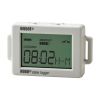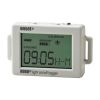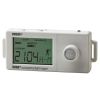HOBO UX90 Motor On/Off Data Logger
The HOBO UX90 motor on/off data logger records conditions within an AC magnetic field using an internal sensor or mechanical dry contact closures from external sensing devices.
Features
- Ideal for tracking usage and runtimes of motors, pumps and compressors
- Available in 128 KB and 512KB memory models
- Expedited repair and warranty service
- Lifetime technical support
- More
Overview
The HOBO UX90 motor on/off logger records motor on/off conditions within an AC magnetic field with its internal sensor, or mechanical dry contact closures from external sensing devices. Ideal for tracking the usage and runtimes of motors, pumps, compressors, and other equipment, this logger is available in a standard 128 KB memory model (UX90-004) capable of 84,650 measurements and an expanded 512KB memory version (UX90-004M) capable of over 346,795 measurements.
| Internal Motor Sensor | |
| AC Magnetic Field Threshold |
>40 mGauss at 60 Hz |
| External Input | |
| External Contact Input |
Electronic solid state switch closure or logic driven voltage output |
| Range |
0 to 3 V DC (USB powered), 0 to 2.5 V DC (battery powered) |
| Maximum State and Runtime Frequency |
1 Hz |
| Solid State Switch Closure |
Input Low: < 10 KΩ; Input High: > 500 KΩ |
| Internal Weak Pull-Up |
100 KΩ |
| Input Impedance |
Solid state switch closure: 100 KΩ pull up |
| Logger | |
| Resolution |
Pulse: 1 pulse, Runtime: 1 second, State and Event: 1 State or Event |
| Memory Modes |
Wrap when full or stop when full |
| Start Modes |
Immediate, push button, date & time, or next interval |
| Stop Modes |
When memory full, push button, or date & time |
| Power Source |
One 3V CR2032 lithium battery and USB cable |
| Battery Life |
1 year, typical with logging intervals greater than 1 minute and normally open contacts |
| Memory |
UX90-004: 128 KB (84,650 measurements, maximum) UX90-004M: 512 KB (346,795 measurements, maximum) |
| Download Type |
USB 2.0 interface |
| Full Memory Download Time |
10 seconds for 128 KB; 30 seconds for 512 KB |
| Logger Operating Range |
Logging: -20° to 70°C (-4° to 158°F); 0 to 95% RH (non-condensing) Launch/Readout: 0° to 50°C (32° to 122°F) per USB specification |
| LCD |
LCD is visible from: 0° to 50°C (32° to 122°F); the LCD may react slowly or go blank in temperatures outside this range |
| Size |
3.66 x 8.48 x 1.52 cm (1.44 x 3.34 x 0.6 in.)
|
| Weight |
30 g (1.06 oz)
|
| Environmental Rating |
IP50 |
- HOBO UX90-004x Motor On/Off Data Logger
- Command strip
- Double-sided tape
- Hook & loop strap
In The News
From Paddles to Phytoplankton: Studying Vermont’s Wildest Lakes
For six months of the year, Rachel Cray, a third-year PhD student at the Vermont Limnology Laboratory at the University of Vermont, lives between a microscope and her laptop, running data. For the other six months, she is hiking and canoeing four of Vermont’s lakes, collecting bi-weekly water samples. Cray studies algal phenology across four lakes in Vermont, US, that have low anthropogenic stress—or in other words, are very remote. Funded by the National Science Foundation Career Award to Dr. Mindy Morales, the lakes Cray researches part of the Vermont Sentinel Lakes Program, which studies 13 lakes in the area and, in turn, feeds into the Regional Monitoring Network, which operates in the Northeast and Midwest US.
Read MoreReimagining Water Filtration: How Monitoring and Science Enhance FloWater Filtration Systems
Over 50% of Americans think their tap water is unsafe , according to the Environmental Working Group (EWG). Other recent surveys have found that number to be as high as 70% of persons surveyed. Whether due to increased public awareness of water quality issues or confusion about how municipal water sources are regulated, there is a clear distrust of tap water in the United States. According to industry expert Rich Razgaitis, CEO and co-founder of the water purification company FloWater, this issue creates a damaging cycle. Razgaitis explained that the health and environmental problems associated with contaminated water aren’t the only issues. As people become increasingly aware that some tap water is unsafe, they resort to bottled water.
Read MoreMonitoring New Hampshire’s Aquatic Ecosystems: Continuous Data Collection in the Lamprey River Watershed
New Hampshire’s aquatic ecosystems provide a range of ecosystem services to the state and region. Resources and services like clean water, carbon storage, climate regulation, nutrient regulation, and opportunities for recreation all depend on New Hampshire’s aquatic ecosystems remaining healthy. Jody Potter, an analytical instrumentation scientist at the University of New Hampshire (UNH), is studying these aquatic ecosystems in hopes of developing an improved understanding of ecosystem services and their interactions with climate change, climate variability, and land use changes. [caption id="attachment_39799" align="alignnone" width="940"] Aquatic sensors in the Merrimack River in Bedford, NH, with I-293 in the background.
Read More














